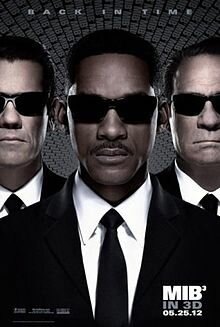 The “Men In Black” stories are by definition secret histories, so it’s natural to find the franchise reaching back into history, to 1969 and the Apollo 11 launch specifically. But non-specifically, since these movies put out that we, the audience, understand nothing that’s really going on, a touchstone to a past point where paranoia’s just about to break over the ocean of achievement, makes perfect sense. The films, derived originally from a comic book series written by Lowell Cunningham, wax almost Lovecraftian in their sense of what must be supressed, blocked, kept from the public record. However, Lovecraft’s otherworldly forces had to be kept from breaking through. In the world Cunningham made, they’re already here. The wheelings and dealings they do with Earthlings (“Dad, I’m on Earth, I need bail,” quavers an exceptionally Bug-Eyed Monster) have to be covered up. Any war is already over.
The “Men In Black” stories are by definition secret histories, so it’s natural to find the franchise reaching back into history, to 1969 and the Apollo 11 launch specifically. But non-specifically, since these movies put out that we, the audience, understand nothing that’s really going on, a touchstone to a past point where paranoia’s just about to break over the ocean of achievement, makes perfect sense. The films, derived originally from a comic book series written by Lowell Cunningham, wax almost Lovecraftian in their sense of what must be supressed, blocked, kept from the public record. However, Lovecraft’s otherworldly forces had to be kept from breaking through. In the world Cunningham made, they’re already here. The wheelings and dealings they do with Earthlings (“Dad, I’m on Earth, I need bail,” quavers an exceptionally Bug-Eyed Monster) have to be covered up. Any war is already over.
The conceptual masterstroke: To place Andy Warhol at a locus of alien activity in Manhattan, and to have him not actually be Andy Warhol in the first place–the ultimate act of self-elimination that “our own” Warhol never quite mastered. No, Warhol, or whoever is supposed to be Warhol, exists as the rest of the Men In Black do, to watch, and to facilitate. And who better than “Warhol,” so freaky and mumbly that no one pays him any heed as he squints through his viewfinder, through his smoked sunglass lens, to watch (mostly) and facilitate (where necessary)? He’s the least likely suspect for manning the barricades.
Will Smith ages and handles 1969-grade racism gracefully. Tommy Lee Jones took his money and ran. Josh Brolin, as the younger version of Jones’ character, manages with simple language and minute variations on a stone face, to manifest a kind, gentle man caught in a world where kindness and gentleness sit beside the point. More like this and he may win praise for a serious performance in a serious, less systematically secret, milieu.